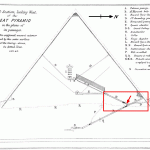
The Granite Plugs of the Great Pyramid
The Great Pyramid on the Giza plateau at the apex of the Nile delta is one of the oldest and largest and yet perhaps the most enigmatic manmade structure in recorded history. Egyptologists have determined that it was commissioned by the pharaoh Khufu in the 4th Dynasty of the Old Kingdom to be his royal tomb. Figure 1 shows a vertical cross section indicating the main passages and chambers. However, within these passages and chambers are many elements of construction that are difficult to explain within the context of a royal tomb. This article focuses on one such enigma: the set of three massive granite blocks that plug the lower end of the Ascending Passage. [more…]
 By
By